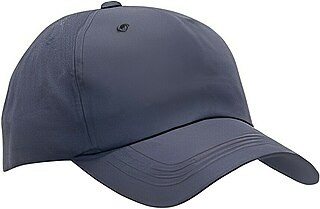Related Research Articles
A cap is a form of headgear.

The Phrygian cap or liberty cap is a soft conical cap with the apex bent over, associated in antiquity with several peoples in Eastern Europe and Anatolia, including the Persians, the Medes and the Scythians, as well as in the Balkans, Dacia, Thrace and in Phrygia, where the name originated. The oldest depiction of the Phrygian cap is from Persepolis in Iran.

A baseball cap is a type of soft hat with a rounded crown and a stiff bill projecting in front.
A cap is a flat headgear, usually with a visor. Caps have crowns that fit very close to the head. They made their first appearance as early as 3200 BC. The origin of the word "cap" comes from the Old French word "chapeau" which means "head covering". Over time, the word has evolved and changed its meaning, but it still retains its association with headwear. Caps typically have a visor, or no brim at all. They are popular in casual and informal settings, and are seen in sports and fashion. They are typically designed for warmth, and often incorporate a visor to block sunlight from the eyes. They come in many shapes, sizes, and are of different brands. Baseball caps are one of the most common types of cap.

A beer bottle is a bottle designed as a container for beer. Such designs vary greatly in size and shape, but the glass commonly is brown or green to reduce spoilage from light, especially ultraviolet.

The peaked cap, peaked hat, service cap, barracks cover or combination cap is a form of headgear worn by the armed forces of many nations, as well as many uniformed civilian organisations such as law enforcement agencies and fire departments. It derives its name from its short visor, or peak, which was historically made of polished leather but increasingly is made of a cheaper synthetic substitute.
A half-arch is the piece of gold, silver or platinum, usually decorated with jewels, that links the circlet of a hoop crown to the monde at the top of the crown.

The Small Diamond Crown of Queen Victoria is a miniature imperial and state crown made at the request of Queen Victoria in 1870 to wear over her widow's cap following the death of her husband, Prince Albert. It was perhaps the crown most associated with the queen and is one of the Crown Jewels on public display in the Jewel House at the Tower of London.
A recorder is a judicial officer in England and Wales and some other common law jurisdictions.

Monomakh's Cap, also called the Golden Cap, is a chief relic of the Muscovite Grand Princes and Russian Tsars. It is a symbol-crown of the Russian autocracy, and is the oldest of the crowns currently exhibited at the Imperial treasury section of the Kremlin Armoury. Monomakh's Cap is an early 14th-century gold filigree skullcap composed of eight sectors, elaborately ornamented with a scrolled gold overlay, inlaid with precious stones and pearls, and trimmed with sable. The cap is surmounted by a simple gold cross with pearls at each of the extremities.
Crown Holdings, Inc., formerly Crown Cork & Seal Company, is an American company that makes metal beverage and food cans, metal aerosol containers, metal closures and specialty packing. Founded in 1892, it is headquartered in Yardley, Pennsylvania. As of their annual report for 2020, Crown employs 33,264 people at 192 plants in 39 countries. It claims to manufacture one out of every five beverage cans used in the world, and one out of every three food cans used in North America and Europe. The company is ranked No. 286 in the Fortune 500 list for 2022 and is number one in the packaging and container industry for the same list.

A kufi or kufi cap is a brimless, short, and rounded cap worn by men in many populations in North Africa, East Africa, West Africa, South Asia, and the Middle East. It is also worn by men throughout the African diaspora. The hat has strong associations with many Islamic cultures, as well as Pan-African pride. It is commonly called a "topi" or "tupi" in the Indian subcontinent. The kufi is similar to the kippah in Jewish culture.

Typical of British heraldry, a cap of maintenance, known in heraldic language as a chapeau gules turned up ermine, is a ceremonial cap of crimson velvet lined with ermine, which is worn or carried by certain persons as a sign of nobility or special honour. It is worn with the high part to the fore, and the tapering tail behind. It may substitute for the torse in the heraldic achievement of a person of special honour granted the privilege by the monarch. It thus appears in such cases on top of the helm and below the crest. It does not, however, feature in the present royal coat of arms of the United Kingdom, which shows the royal crest upon the royal crown, itself upon the royal helmet.

In the manufacture of pharmaceuticals, encapsulation refers to a range of dosage forms—techniques used to enclose medicines—in a relatively stable shell known as a capsule, allowing them to, for example, be taken orally or be used as suppositories. The two main types of capsules are:

In various European countries, student caps of different types are, or have been, worn either as a marker of a common identity, as is the case in the Nordic countries, or to identify the wearer as a member of a smaller body within the larger group of students, as is the case with the caps worn by members of German Studentenverbindungen, or student groups in Belgium.

The Balmoral bonnet is a traditional Scottish hat that can be worn as part of formal or informal Highland dress. Developed from the earlier blue bonnet, dating to at least the 16th century, it takes the form of a knitted, soft wool cap with a flat crown. It is named after Balmoral Castle, a royal residence in Scotland. It is an alternative to the similar and related (informal) Tam o' Shanter cap and the Glengarry bonnet.

A mariner's cap also called a skipper's cap,sailor's cap or fiddler's cap, is a peaked cap, usually made from black or navy blue wool felt, but also from corduroy or blue denim. Originally popular with seafarers, it is often associated with sailing and maritime settings, especially fishing, yachting and recreational sailing. It has sometimes become a fashion item in the West, for example being worn by John Lennon in the mid-1960s.

A jokduri is a type of traditional Korean coronet worn by women for special occasions such as weddings. Also known as a jokdu or jokgwan, it consists of an outer crown covered with black silk, and an inner which is filled with cotton and hard paper. Its top is decorated with cloisonné ornaments. The upper part is vaguely hexagonal and the bottom is cylindrical. The form of the jokduri gets narrower towards its base.
A cone top is a type of can, especially a type of beverage can, introduced in 1935. Cone tops were designed in response to flat top beer cans as a hybrid between beer bottle and flat top can. Cone tops were especially attractive to smaller breweries which did not have the capital necessary to buy new canning machinery; cone tops could be filled on standard bottling equipment.
References
- ↑ Norris, Herbert (1 January 1999). Medieval Costume and Fashion. Courier Corporation. p. 177. ISBN 978-0-486-40486-8.
